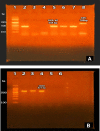Carbapenem-Resistant Klebsiella pneumoniae Among Patients with Ventilator-Associated Pneumonia: Evaluation of Antibiotic Combinations and Susceptibility to New Antibiotics
- PMID: 35833009
- PMCID: PMC9271681
- DOI: 10.2147/IDR.S371248
Carbapenem-Resistant Klebsiella pneumoniae Among Patients with Ventilator-Associated Pneumonia: Evaluation of Antibiotic Combinations and Susceptibility to New Antibiotics
Abstract
Background: Carbapenemase-producing Gram-negative bacteria, particularly Klebsiella pneumoniae (K. pneumoniae), are at the forefront of the list of causative agents of ventilator-associated pneumonia (VAP). The treatment options for such infections are limited, and various antimicrobial combinations have been suggested as alternatives in clinical practice. New antibiotics, such as ceftazidime/avibactam, ceftolozane/tazobactam and cefiderocol, have shown advantages in both in vitro and clinical studies.
Purpose: To evaluate the in vitro effect of meropenem-ciprofloxacin and meropenem-colistin combinations on carbapenem-resistant (CR) K. pneumoniae VAP isolates and to determine their susceptibility to new antibiotics.
Methods: Seventy-three K. pneumoniae isolates from 176 endotracheal samples from VAP cases were studied. Antibiotic susceptibility testing and phenotypic detection of extended-spectrum β lactamase (ESBL) and carbapenemase production were done. CR K. pneumoniae isolates were tested for the five predominant carbapenemase genes (bla KPC, bla OXA-48, bla NDM, bla VIM, and bla IMP). In vitro evaluation of meropenem-ciprofloxacin and meropenem-colistin combinations was done by MIC test strips. Susceptibility to new antibiotics was tested by disk diffusion method.
Results: Sixty-three (86.3%) of the isolates were ESBL producers and 52 (71.2%) were carbapenem resistant. Bla NDM was the most prevalent carbapenemase gene (50%), followed by bla OXA-48, (36.5%) then bla KPC in (11.5%). Bla VIM and bla IMP were not detected. Meropenem-ciprofloxacin combination showed indifferent effect on all isolates, while meropenem-colistin combination showed 25% synergism, 15.4% addition and 59.6% indifference. All (100%) CR K. pneumoniae isolates were resistant to ceftolozane/tazobactam and 79% were resistant to ceftazidime/avibactam, while 96% were sensitive to cefiderocol.
Conclusion: A high rate of carbapenem resistance exists among VAP K. pneumoniae isolates. Meropenem-colistin combination and cefiderocol appear to be potential treatment options for infections caused by CR K. pneumoniae. Resistance to the tested new β-lactam/β-lactamase inhibitors was high, signifying a major threat.
Keywords: Klebsiella pneumoniae; carbapenem resistant; carbapenemases; combination; new antibiotics; ventilator-associated pneumonia.
© 2022 Ramadan et al.
Conflict of interest statement
The authors report no conflicts of interest in relation to this work.
Figures



Similar articles
-
[In Vitro Activity of Ceftazidime-avibactam and Colistin Against Carbapenem-Resistant Klebsiella pneumoniae Clinical Isolates].Mikrobiyol Bul. 2022 Apr;56(2):218-229. doi: 10.5578/mb.20229803. Mikrobiyol Bul. 2022. PMID: 35477226 Turkish.
-
Clinical carbapenem-resistant Klebsiella pneumoniae isolates simultaneously harboring bla NDM-1, bla OXA types and qnrS genes from the Kingdom of Bahrain: Resistance profile and genetic environment.Front Cell Infect Microbiol. 2022 Oct 11;12:1033305. doi: 10.3389/fcimb.2022.1033305. eCollection 2022. Front Cell Infect Microbiol. 2022. PMID: 36304935 Free PMC article.
-
In vitro activity of cefiderocol against European Enterobacterales, including isolates resistant to meropenem and recentβ-lactam/β-lactamase inhibitor combinations.Microbiol Spectr. 2024 Jun 21;12(8):e0418123. doi: 10.1128/spectrum.04181-23. Online ahead of print. Microbiol Spectr. 2024. PMID: 38904361 Free PMC article.
-
Cefiderocol: A Siderophore Cephalosporin with Activity Against Carbapenem-Resistant and Multidrug-Resistant Gram-Negative Bacilli.Drugs. 2019 Feb;79(3):271-289. doi: 10.1007/s40265-019-1055-2. Drugs. 2019. PMID: 30712199 Review.
-
Microbiology of Meropenem-Vaborbactam: A Novel Carbapenem Beta-Lactamase Inhibitor Combination for Carbapenem-Resistant Enterobacterales Infections.Infect Dis Ther. 2020 Dec;9(4):757-767. doi: 10.1007/s40121-020-00350-1. Epub 2020 Oct 5. Infect Dis Ther. 2020. PMID: 33017041 Free PMC article. Review.
Cited by
-
Co-existence of antibiotic resistance and virulence factors in carbapenem resistant Klebsiella pneumoniae clinical isolates from Alexandria, Egypt.BMC Microbiol. 2024 Nov 11;24(1):466. doi: 10.1186/s12866-024-03600-1. BMC Microbiol. 2024. PMID: 39528926 Free PMC article.
-
Early Predictive Value of Infectious Markers for Ventilator-associated Pneumonia after Stanford Type A Aortic Dissection Surgery.Rev Cardiovasc Med. 2025 Feb 17;26(2):26002. doi: 10.31083/RCM26002. eCollection 2025 Feb. Rev Cardiovasc Med. 2025. PMID: 40026526 Free PMC article.
-
Molecular Screening of Carbapenem-Resistant K. pneumoniae (CRKP) Clinical Isolates for Concomitant Occurrence of Beta-Lactam Genes (CTX-M, TEM, and SHV) in the Kingdom of Bahrain.J Clin Med. 2023 Dec 5;12(24):7522. doi: 10.3390/jcm12247522. J Clin Med. 2023. PMID: 38137591 Free PMC article.
-
Carbapenem-resistant hypermucoviscous Klebsiella pneumoniae clinical isolates from a tertiary hospital in China: Antimicrobial susceptibility, resistance phenotype, epidemiological characteristics, microbial virulence, and risk factors.Front Cell Infect Microbiol. 2022 Dec 21;12:1083009. doi: 10.3389/fcimb.2022.1083009. eCollection 2022. Front Cell Infect Microbiol. 2022. PMID: 36619764 Free PMC article.
-
Prevalence of colistin resistance in multidrug-resistant Klebsiella pneumoniae recovered from clinical samples in Africa: a systematic review and meta-analysis.JAC Antimicrob Resist. 2025 Jul 18;7(4):dlaf119. doi: 10.1093/jacamr/dlaf119. eCollection 2025 Aug. JAC Antimicrob Resist. 2025. PMID: 40687207 Free PMC article. Review.
References
-
- Pozuelo-Carrascosa DP, Cobo-Cuenca AI, Carmona-Torres JM, Laredo-Aguilera JA, Santacruz-Salas E, Fernandez-Rodriguez R. Body position for preventing ventilator-associated pneumonia for critically ill patients: a systematic review and network meta-analysis. J Intensive Care. 2022;10(1):9. doi:10.1186/s40560-022-00600-z - DOI - PMC - PubMed
LinkOut - more resources
Full Text Sources
Miscellaneous

